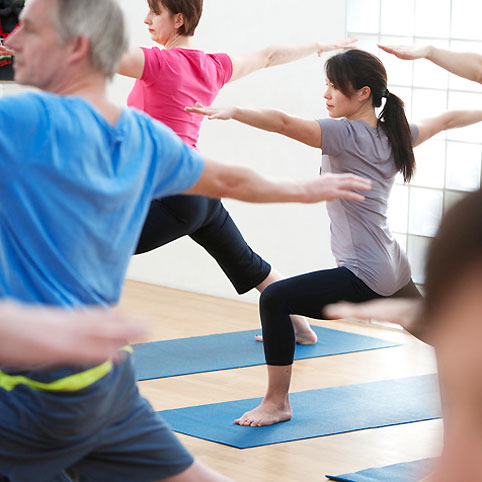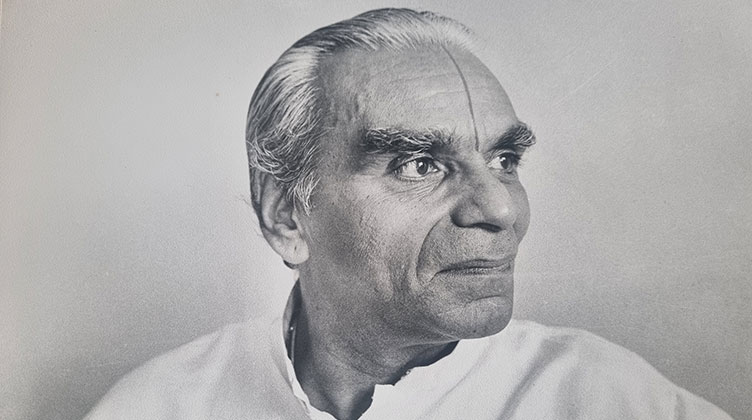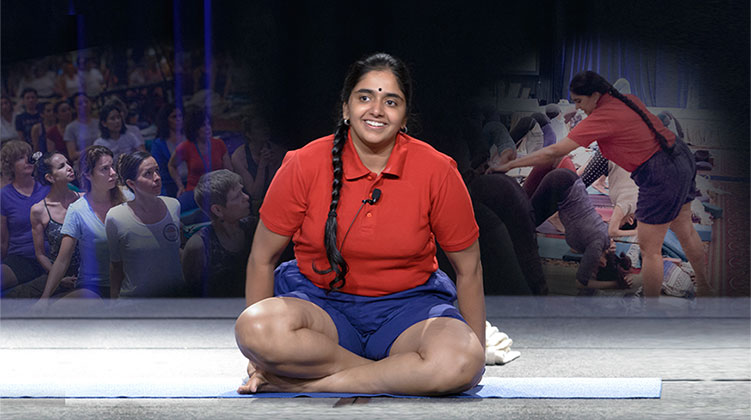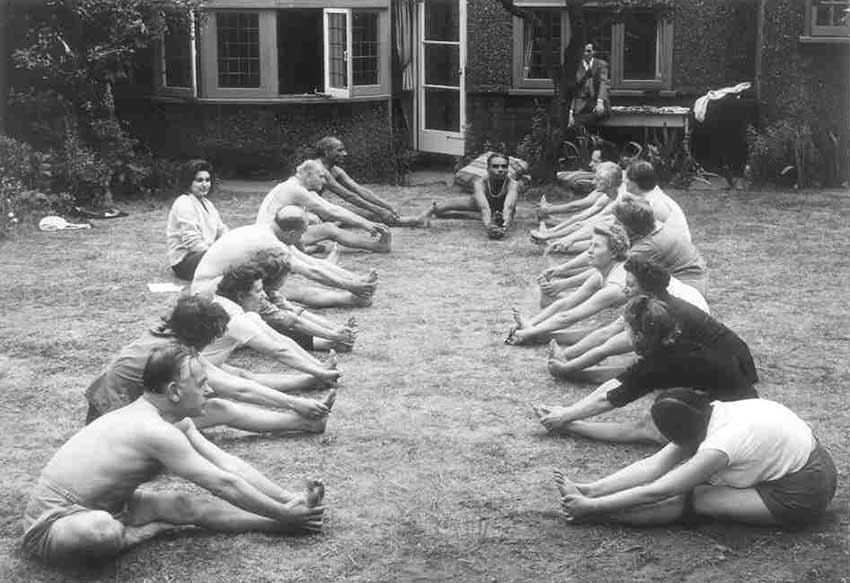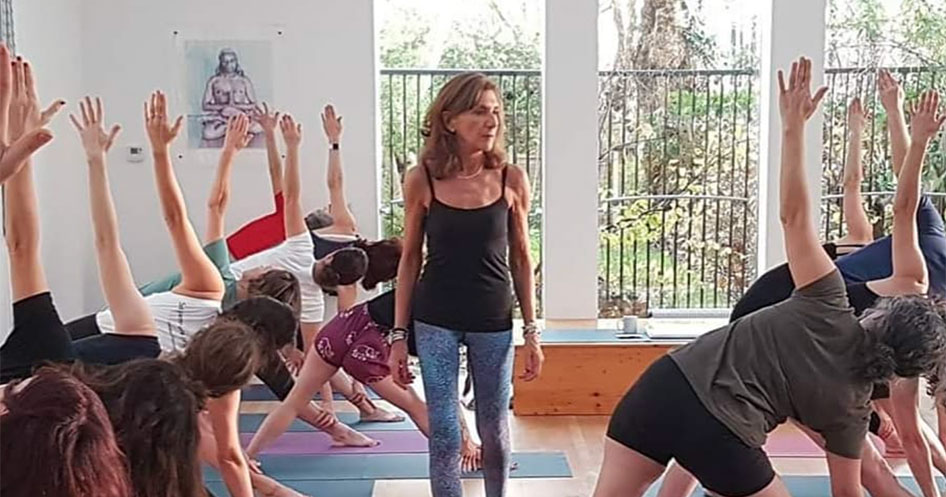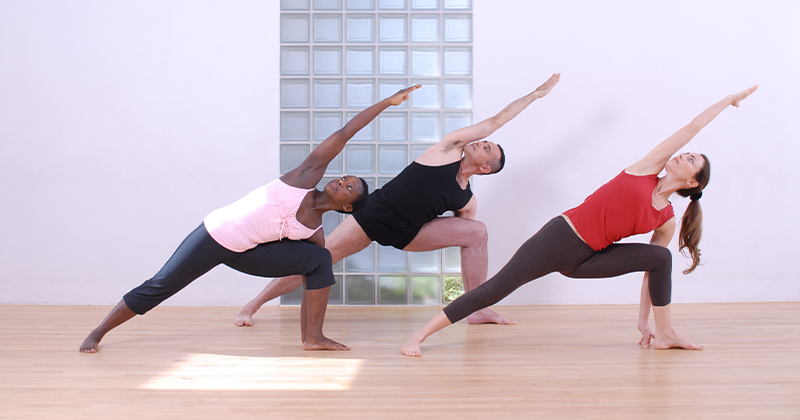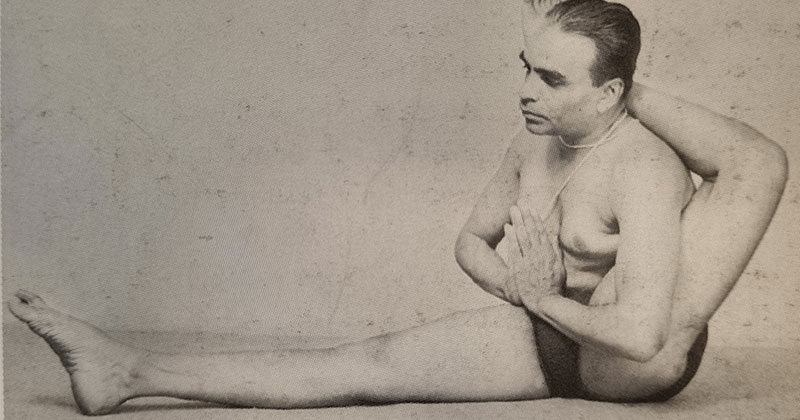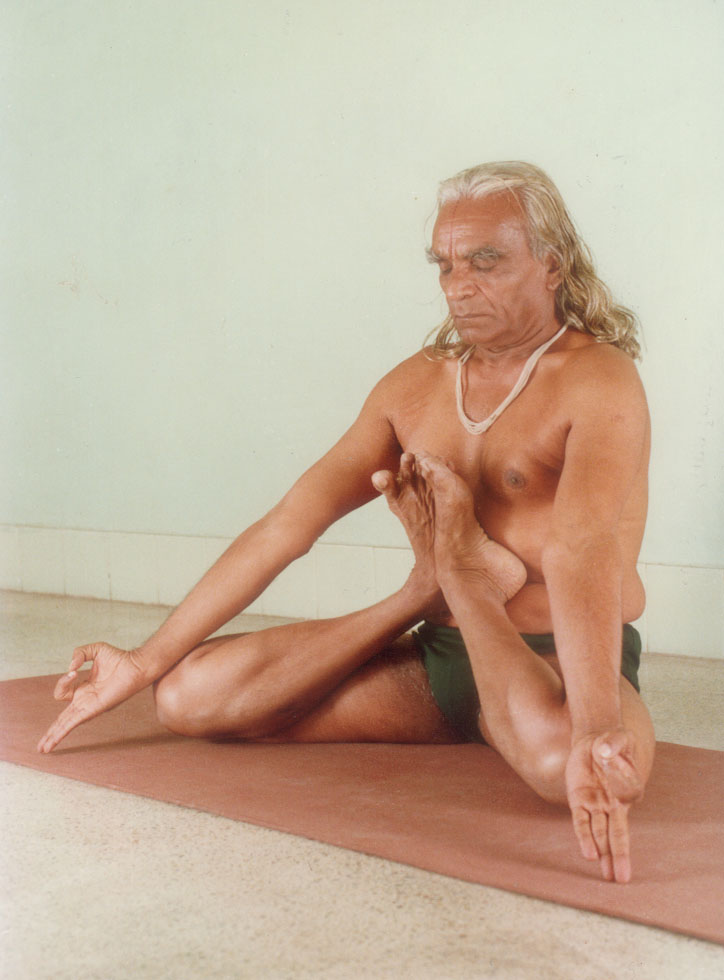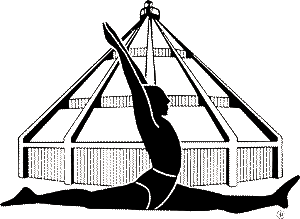
The IYUK Long Covid pilot study was conducted from October to December 2021. It was initiated by Gerda Bayliss, an Iyengar Yoga teacher, who contracted Covid and was left with severe Long Covid (LC). Her parents, Alan Brown and Diana Bayliss, also Iyengar Yoga teachers, helped with her recovery. She also received advice from Lois Steinberg in the US, attending her online classes. Together with the therapy committee of IYUK, they devised a suggested Iyengar yoga programme for those with Long Covid. This programme is based on Lois Steinberg’s respiratory system practice. The study is being evaluated by an independent researcher from York St John University. It is hoped that the results will provide evidence that Iyengar Yoga can help in the recovery from Long Covid.
The pilot study took ten weeks and involved ten groups. Each group had five to six students, one Therapy teacher (TT), responsible for the whole group, and two teachers looking after each student (ten to twelve teachers in each group). Of the two teachers, one had some therapy experience whereas the other did not necessarily have a background in therapy. Each group had a class on a specific day, which took about 90 minutes. The whole project ran on a purely voluntary basis, with no cost for the students and no renumeration for the teachers. Many IYL teachers were involved in this project.

Here, we present the views of two participants: a teacher, whose diary extracts record her role in the study and a student, who kindly gave an account of her experience.
The Teacher’s Perspective
By Ann Traynor
Ann lives in Armagh (Northern Ireland) and has taught Iyengar Yoga in NI since 2007.
I was delighted to be accepted as an assisting teacher on the pilot group of the Iyengar Yoga Long Covid Study. My fellow teacher, Shirley, our main supervising therapy teacher and I met ‘our’ student in late September 2021, a young woman who freely told us about how LC had totally incapacitated her. The feeling of responsibility was immense: we were being trusted to introduce Iyengar Yoga to someone in this serious predicament. There were a few training sessions with the therapy committee, headed by Sheila Haswell, and Lois Steinberg.
Everything was conducted online and we were not physically together at any point. After some email correspondence, and an initial meeting with all the teachers in our group, we interviewed our students. They had 15–20 minutes to tell us about themselves and to ask us questions. It was a little bit like speed dating, especially for our therapy teacher (TT), who ‘jumped’ from one interview to another. The interview was the first of the ten sessions of the study.
WEEK 1
I shall call our student Mandy (not her real name). The interview gave us a picture of her symptoms so that the therapy teacher could prepare a tailor-made programme for her (and for the other five students in the group). The programme was there to help with LC but also any other physical problems which needed to be addressed. I asked Mandy what prompted her to join this study. She said that she had been searching online for help and found that other support groups were more about accepting life with LC, whereas this study aimed to restore physical and mental wellbeing.
Before catching Covid in March 2020, Mandy had been in good physical and mental health. Her Covid symptoms were a sore throat, extreme fatigue, fever/chills, headaches and shortness of breath. She was diagnosed with LC in May 2020 and after 17 months she was still suffering from fatigue, headaches, dizziness and poor mental health. These symptoms were extremely debilitating and significantly disrupted her life. Mandy said that it felt like she was living in someone else’s body.
WEEK 2
Mandy, Shirley and I carefully dipped a toe (or toes) into the water. We introduced the programme devised by our TT. We worked at a slow, steady pace. Mandy wasn’t an Iyengar Yoga student but was very adept at understanding how to position the props. She had acquired some equipment but we also used a lot of her home furnishings. Shirley and I were comfortable working together and quickly found that teaching alternate poses gave us time to take notes and screenshots. Each week, the students had to fill in a pre- and post-session form which asked about their Covid symptoms, especially fatigue, pain and mental health.
In her pre-session form, Mandy notified us that she had started to get pain in her left knee, particularly when climbing stairs. She was also experiencing some lower back pain and pain in her left shoulder. After a poor night’s sleep, she was a bit groggy. Physically and emotionally, she was feeling quite bad.
In her post-session form, she stated that she was feeling quite good physically and very good emotionally. She said that because this was the first session, she didn’t know what to expect and hoped that the following week would be much easier with regard to equipment and organising her practice space. “I felt incredibly supported by the teachers and am really looking forward to future weeks”.
“Everything was conducted online and we were not physically together at any point.”
WEEK 3
Feeling better prepared, having studied screenshots and notes from the previous week, we repeated the programme, adjusting props and poses as necessary. Mandy was still experiencing fatigue, headaches, joint pain and heartburn, and had difficulty concentrating. Again, our approach was slow and steady. With the help of breakout rooms, our TT could pop in periodically. With her sharp eye, she was often able to improve the pose. (‘Breakout rooms’ is a Zoom facility that lets the host join multiple meetings that are running concurrently and separately.)
In her pre-session form, Mandy stated that life had been a bit chaotic because her husband had tested positive for Covid four days earlier. Keeping him isolated in the house had disrupted many routines. She was feeling better herself, but was still pacing herself to make sure she did not overdo it.
Post-session, she reported back: “I found this class easier as I knew how/where to set up for poses. The poses were relaxing and I felt the benefit afterwards. In the evening I was tired (but not the normal LC fatigue), and I fell asleep very early.”
Despite having had two vaccines during the summer, Mandy unfortunately caught Covid again and was unable to attend for three weeks. We were given permission by the LC study group committee to continue when Mandy felt well enough to resume. Our TT prepared a revised programme for us to follow.

Supta Baddha Konasana

Viparita Karani with chair
WEEK 7
Mandy returned and told us about her recent bout of Covid. The second time was not as severe as the first; she likened it to a bad cold, whereas her first Covid infection was much worse than the worst flu one could imagine. However, her experience of becoming breathless after small tasks had returned. For example, bringing the bolster downstairs before the class left her breathless. She was delighted to be back but was not sure how much she would be able to do.
We gave her Supta Baddha Konasana (see photo) on one layer of foam blocks spinewise, with a blanket under her head. Mandy said it felt very good. Viparita Karani (see photo) was done with a chair, the buttocks on foam blocks and the calves bent on the chair with more foam blocks under them. Mandy was completely relaxed. After six minutes, I asked if she would like to prepare to come out; she replied, “You could leave me here until next Saturday and I would be happy to stay”. She finished the class with supported Prone Savasana. We were unsure if this pose would be suitable today, but Mandy remained still and looked good so I left her for three minutes. After coming out she said, “Initially I did not think it was comfortable but was so surprised when you told me I had been there for three minutes.” She was really pleased to be back and was surprised to be able to do as much as she did. She did feel tired and said she would have a lie down. It was not the poses that made her feel tired, she said, it was moving the props.
On her pre-session form she wrote: “It’s so good to be filling in the form again and I’m so sorry to have missed so many weeks. I’m almost recovered from the recent Covid infection. I have seen a worsening of my fatigue from LC but I’ve seen an improvement in energy levels over this week and I’ve been up and about much more.”
Post-session: “I felt very tired immediately after the class and rested. However, in the evening my energy levels rose, which was great. I had a good night’s sleep”.

Pavana Muktasana

Chair Adho Mukha Svanasana
WEEK 8
Mandy looked much brighter and she felt much better today. She has taken the dog for a walk, feeling confident and strong enough to go on her own. We began the class with Pavana Muktasana (see photo), forward to a bolster with the head end raised. She experienced the feeling of the chest opening from back to front. Then she did the L-shapes, sitting upright, arching backwards and going forwards in Dandasana and Upavistha Konasana with a belt around her feet, which worked well. She really felt the work in her legs, was able to lift her chest much more than the week before and was able to hold the poses well. A great success! According to her, they were much easier today and she even enjoyed them. It felt like she had her own body back again. Moving the props was no longer a problem.
Pre-session she was feeling much better and more energetic.
Post-session, Mandy reported: “I felt tired initially and then revived later in the evening. My body felt different – stretched out. I found the support from the teachers so emotionally encouraging. Thank you.”
WEEK 9
Mandy looked great today and had felt much better all week. Sitting down for a rest is now enough to revive her to get up and go again. We gave Tadasana with a brick lengthwise held between her thighs and knees for 30 seconds; Mandy felt the work in her legs. She also put the Pune shoulder jacket on to open her chest more. Prasarita Padottanasana with the head to a chair and the bolster crosswise, giving support for forehead and elbows, was successful. It was very relaxing for her shoulders. Interestingly, Mandy said that she felt the upright and backwards version of the L-shapes were easier today after the shoulder preparations. For Supta Baddha Konasana, Mandy could get down to the floor with more ease. She had also noticed that it was easier to empty the dishwasher. Mandy had no problem managing her props today, her energy levels were very good.
Pre-session: Mandy reported a sustained improvement; she is now able to walk further (for 20–30 minutes).
Post-session: “I really enjoyed the class and it gave me a real boost feeling the improvements.”
WEEK 10
Mandy was in fine form today, having really enjoyed a weekend with her friends. She went on a couple of walks but otherwise paced herself, so that she was able to take part in all the other social activities. Her week had been busy, with the usual routine returning plus additional Christmas tasks. She was pleased that she was experiencing normal tiredness again, instead of fatigue.
Mandy was able to hold Tadasana with the brick more easily now her legs have regained some strength. In Chair Adho Mukha Svanasana (see photo), she was able to work her arms and legs. She could also work her legs considerably more in the L-shapes and had no problems repositioning her props. Supta Baddha Konasana was a well-earned rest, so she chose to stay a little longer. Mandy definitely had more strength today.
Post-session form: Mandy stated that her mental and physical health were very good compared to the first session back in October, when she stated that both were “quite bad”.
I have been very privileged to be part of this study. Mandy has been a brilliant student, prepared to commit despite everything she has been through, both before and during the study. She has come on leaps and bounds since returning after a second bout of Covid.
In closing, I would like to say to Shirley, my co-teacher: You were a great teaching partner, I truly appreciated working with you, thank you. And to our TT: It was a pleasure to be part of this group. Your calm confidence throughout was very encouraging. You trusted us with a student who had suffered Long Covid and a new Covid infection. I only hope that my contribution made a difference, helping to bring Iyengar Yoga to Mandy at a time when she needed it most. The photos are modelled by Ann Traynor and not by the student for reasons of data protection.
The photos above feature Ann Traynor rather than the student for data protection. Photographer: Andrew Breaky
The Student’s Perspective
By Valerie Olleon
Valerie participated from Marseille in France. She used to live in the UK, where she attended Iyengar Yoga classes.
I first had Covid in March 2020 and was diagnosed with Long Covid in April 2021. By then, I had debilitating neurological symptoms and digestive issues, as well as severe insomnia lasting for months on end. When I heard about the Iyengar Yoga therapy pilot study for Long Covid, my symptoms had started to subside, apart from the insomnia, exhaustion and brain fog.
I have been a moderate but persistent Iyengar Yoga practitioner for some years. I was confident yoga would help me get better and I was glad of the opportunity to get back into practising on a regular basis. Apart from that, I wasn’t quite sure what to expect. The weekly, one-and-a-half hour sessions revisited postures I mostly already knew, but with a different emphasis – gentle but thorough and using a lot of supports and props.
From the very first session, the effects were significant and undeniable. I felt incredibly relaxed and soothed afterwards, but what surprised me most was the impact on my mood. I felt uplifted, brighter and energised, seemingly out of nowhere. Part of the surprise was that I hadn’t noticed how low I had felt mentally and emotionally, being more preoccupied with keeping it
together physically.
The night after the first class, I slept better than I had in months. After the initial euphoria, the following days were up and down. I didn’t do much yoga practice during the week, finding it hard to muster the energy to do anything after work. Soon it became apparent that the night following my weekly yoga session was the best sleep of the week.

Purvottanasana

Prasarita Padottanasana
Gradually my sleep also become “tamer” outside the sessions. This motivated me to practise during the week, an abridged version of my Long Covid programme lasting 30 to 45 minutes. It seemed to stabilise my sleep and improve my mood for the rest of the week. My evening sessions included about ten poses drawn from our weekly meetings. Of these, I found the following
poses the most helpful: Purvottanasana (see photo) with bolsters supporting my upper trunk, which lifted my heart and spirits and at the same time helped me recover from the day’s work; supported Prasarita Padottanasana (see photo) which brought blood back to my head and brain and kept my abdomen relaxed and supported; finally, Ardha Halasana (see photo) on a chair, which really helped to still my mind, release any remaining tension and induce sleep.

Ardha Halasana
As I became more familiar and confident with the sequence and way of using the props, it became easier to sustain this regime.
It has been many weeks since the end of the project and I am still practising. Apart from a relapse around Christmas and New Year (probably due to lack of practice, late nights and rich foods!), my sleep is pretty stable. I still get “off” nights and short nights, but less so, and more importantly, I am able to function. There are still ups and downs, but on the whole, I feel better physically and mentally.
“One of the great things about this project was that I was able to get help and, by the end of it, I had been taught to help myself.”
With Long Covid, I often felt stranded and baffled by what was happening to me, particularly before being diagnosed. One of the great things about this project was that I was able to get help and, by the end of it, I had been taught to help myself.
I experienced how yoga really works, bringing relief and delivering improvement. The quiet, supportive space that my teachers provided during those weeks was invaluable. I was really touched by their care and attention. I’m also grateful for all their advice and their creative input in adapting my home and furnishings to my yoga practice! I really hope this project can be extended to benefit more people.
The poses in the photos have been re-enacted by Valerie for the purpose of this article. Photographer: Line Olleon
This article was first published in Issue 54 (July 2022) of Dipika, the Journal of Iyengar Yoga London Maida Vale
Blog categories
Become a member
Join our community to get reduced class prices, early booking for events and workshops plus access to the studio for self practice.
Recent news and articles
2024 Convention – Group Livestream Event
7 March 2024|
The First Public Iyengar Yoga Class in the UK
22 November 2023|
NEW Hybrid Classes
5 September 2023|
7 Day Visitor’s Pass
26 June 2023|
Geeta Iyengar on Why We Practise Difficult Asanas
26 June 2023|
